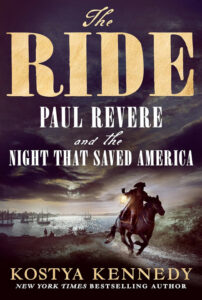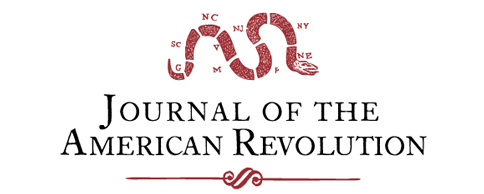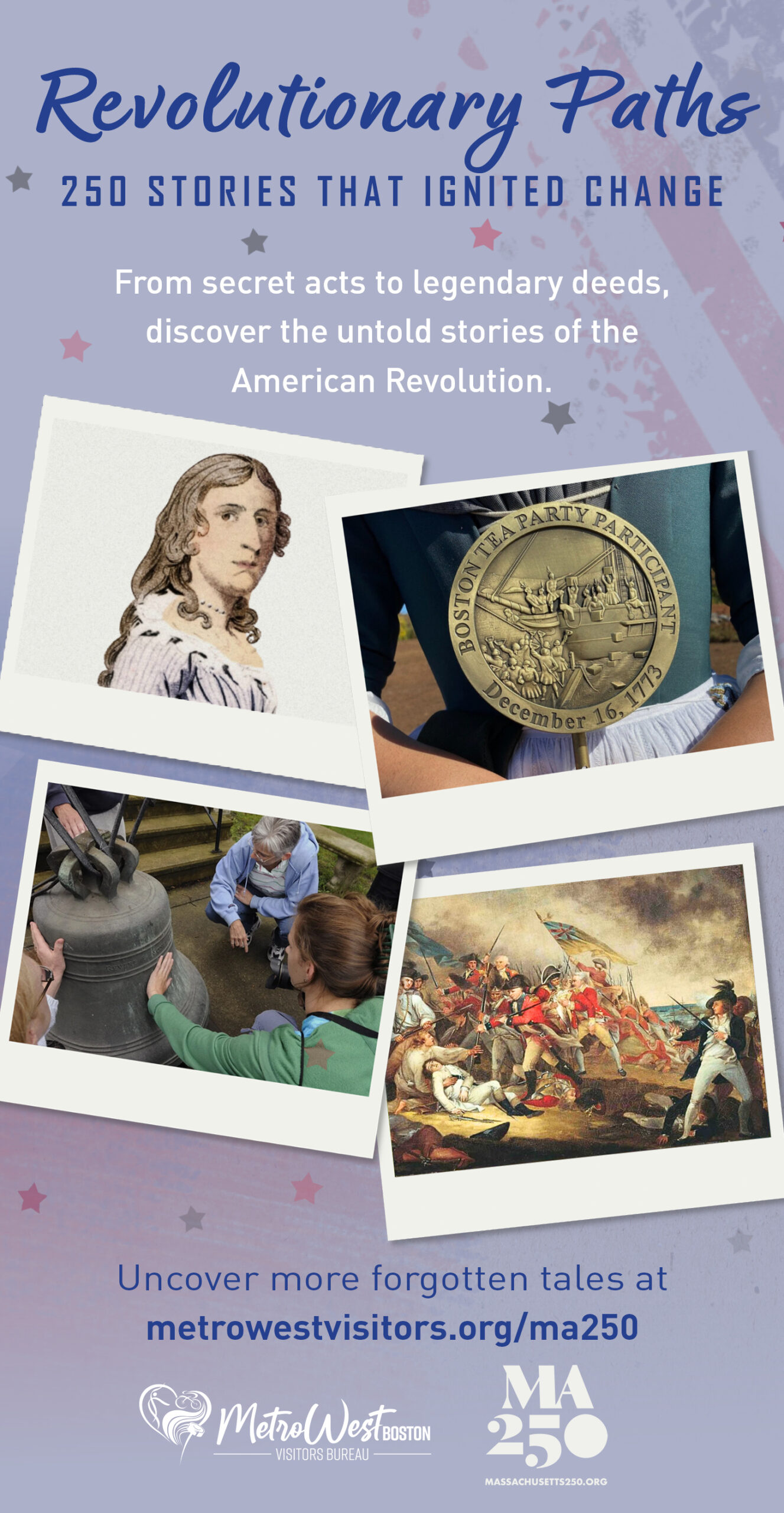BOOK REVIEW: The Ride: Paul Revere and the Night that Saved America by Kostya Kennedy (New York: St. Martin’s Press, 2025)
The story of Paul Revere’s ride through the Massachusetts countryside on the night of April 18-19, 1775, to warn that British troops were on the march, is so familiar that people might believe there is little more to learn about it. However, the well-known outline of the story, as Kostya Kennedy demonstrates in The Ride: Paul Revere and the Night that Saved America, only scratches the surface of an undertaking that Kennedy argues was essential to the success of the American Revolution.
 Kennedy begins his book by posing an intriguing question: What might have happened if Massachusetts militia had not been present at either Lexington or Concord when British troops arrived on April 19? He speculates that John Hancock and Samuel Adams could have been captured or killed, that the munitions at Concord could have been seized, and that such events might have put the American Revolution on a completely different, perhaps even unsuccessful, course. In Kennedy’s view, the question that gives rise to this hypothetical scenario can also be stated as: What might have happened had Paul Revere not made his ride to warn the inhabitants of towns outside Boston that British regulars were coming? While it is impossible to answer such a question, Kennedy uses it to underscore the importance of Revere’s ride, declaring that “Perhaps no night was more critical to [America’s] fate” (page 4).
Kennedy begins his book by posing an intriguing question: What might have happened if Massachusetts militia had not been present at either Lexington or Concord when British troops arrived on April 19? He speculates that John Hancock and Samuel Adams could have been captured or killed, that the munitions at Concord could have been seized, and that such events might have put the American Revolution on a completely different, perhaps even unsuccessful, course. In Kennedy’s view, the question that gives rise to this hypothetical scenario can also be stated as: What might have happened had Paul Revere not made his ride to warn the inhabitants of towns outside Boston that British regulars were coming? While it is impossible to answer such a question, Kennedy uses it to underscore the importance of Revere’s ride, declaring that “Perhaps no night was more critical to [America’s] fate” (page 4).
Having demonstrated the importance of Revere’s mission, Kennedy provides biographical information from Revere’s youth to adulthood, situating Revere within the larger context of Boston’s social groups and discussing his close friendship with fellow Patriot Joseph Warren. In these and other chapters, the author provides background on the several acts of Parliament that ignited colonial protests, such as the Stamp Act and Townshend Acts. Kennedy does not delve deeply into these policies, and usually attributes them to “the Crown,” though in fact they originated in Parliament, and the colonists blamed the king’s ministers and Parliament for their difficulties until the eve of the Revolution, when they redirected their anger against King George III. Kennedy also considers the possibility, as have other historians, that Margaret Kemble Gage, the American wife of British general and Massachusetts royal governor Gen. Thomas Gage, may have been an informant who shared her husband’s plans with Patriots in Boston.
Beginning with chapter five, Kennedy focuses on Revere’s mounted journeys, including his trip to Philadelphia bearing news of the Boston Tea Party, and his September 1774 ride that brought a copy of the Suffolk Resolves to the Continental Congress in Philadelphia. Kennedy devotes a full chapter to Revere’s journey to Portsmouth, New Hampshire, in December 1774, a mission of great (and often overlooked) importance that led to local militia attacking and seizing Fort William and Mary and securing its munitions for the Revolutionaries.
Kennedy begins setting the stage for Revere’s ride in chapter eight, and subsequent chapters provide a thorough account of Revere’s activities before and during his journey, while another focuses on William Dawes, who also rode to warn people outside Boston of the troops’ approach. Kennedy tells the story of Revere’s ride in detail and in dramatic fashion. He follows Revere from his evening meeting with Joseph Warren, his arrangements for two lanterns to be displayed in the North Church steeple as a signal to Charlestown’s Patriot leaders, Revere’s crossing the harbor to Charlestown in a boat rowed by two of his compatriots, and the mounted journey across the dark countryside. The author describes Revere’s successful escape from a British patrol, his subsequent capture by a second group of British officers, and his release. Kennedy does not neglect others who participated in the mission to warn the Massachusetts townspeople; in addition to Dawes, Kennedy discusses Samuel Prescott and lesser-known messengers such as Martin Herrick, Solomon Brown, Jonathan Loring, and Elijah Sanderson. The last three were captured by the same British patrol that captured Revere, and released along with him.
Kennedy intersperses his account of Revere and his actions with chapters that, while of some relevance to the overall story, are tangential to the main narrative. There is a chapter on HMS Somerset, the British warship that Revere had to pass, avoiding the crew’s attention, during his crossing of the Charles River on the night of April 18. Another chapter discusses the case of an enslaved man named Mark, who had been executed in 1755 for poisoning his enslaver; Mark’s remains still hung from a gallows near Charlestown Neck and Revere passed them at the beginning of his ride, a fact Kennedy uses to briefly examine the topic of slavery in Massachusetts. Kennedy concludes the volume by looking at the aftermath of Revere’s ride, with a chapter on Henry Wadsworth Longfellow’s 1860 poem, “The Midnight Ride of Paul Revere,” that helped elevate Revere from a regional hero to a person of national renown, and another on the legacy of Revere’s journey, including accounts of Kennedy’s own experiences while researching the volume.
The Ride is aimed at a general audience, so while it contains a bibliography, there are no footnotes. The book will inevitably draw comparisons to David Hackett Fischer’s Paul Revere’s Ride (New York: Oxford University Press, 1994), which is widely considered the best work on Revere’s mission. There are similarities between the two books, which is to be expected since they address the same topic, but whereas Fischer devotes much attention to General Gage, the British troops, and the fighting at Lexington and Concord, Kennedy largely keeps his focus on Revere and the Massachusetts Patriots. Although this is Kennedy’s first book on Revolutionary history—his previous four covered sports topics—his research is thorough, utilizing a large number of primary and secondary sources, and he writes in an engaging style that includes many interesting details. Academic historians will likely continue to rely on Fischer for information on Revere’s ride and the events that surrounded it, but general readers with an interest in history will find The Ride a compelling and informative account of Paul Revere and his midnight mission that set the stage for the first bloodshed of the American Revolution.





Recent Articles
Lydia’s Tale: The Mystery of Lydia Darragh, Irish Quaker, Patriot Spy
Lt. Elijah Evans of Maryland: Unresolved Promotion in an Extra Continental Regiment
A Journey North: Jefferson, Madison, and the Forging of a Friendship
Recent Comments
"The Evolution of the..."
This article is a gem. Sparkling. Excellent research. Wide and deep. Thank...
"The Evolution of the..."
A very interesting article, thank you! A more general question, if you...
"The Evolution of the..."
Thoroughly researched and a succinct presentation, especially given the article's breadth.